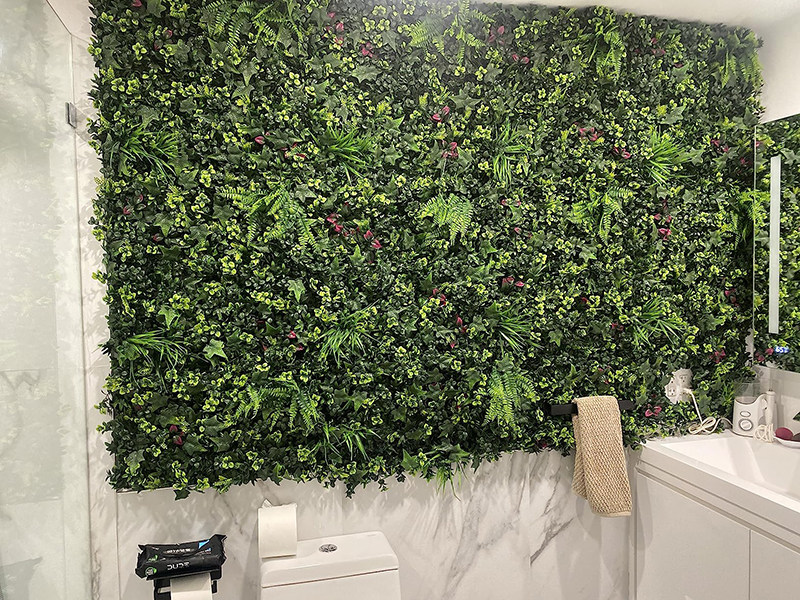Modular installation is a cornerstone of efficient and scalable 3D artificial vertical garden design, offering flexibility, ease of maintenance, and adaptability to diverse environments. By breaking down the garden into interchangeable components, modular systems simplify installation, reduce labor costs, and enable customization. This article explores key aspects of modular installation, including panel design, assembly techniques, and integration with existing structures.
At the heart of modular vertical gardens are interchangeable panels that can be arranged in countless configurations. These panels typically feature a lightweight frame supporting artificial plants, which are pre-attached or easily inserted into slots. The panels’ uniform dimensions allow for seamless alignment, ensuring a cohesive appearance regardless of the garden’s size or shape.
Designers can mix and match panels with different plant species, colors, or textures to create patterns, gradients, or thematic displays. For example, a corporate lobby might use panels with varying shades of green to form a gradient from light to dark, while a playground could incorporate panels with bright, child-friendly foliage. This customization enables vertical gardens to adapt to aesthetic preferences, branding, or educational themes.
Additionally, modular panels simplify repairs or updates. If a panel is damaged or outdated, it can be replaced individually without disrupting the rest of the garden. This flexibility is particularly valuable in high-traffic areas where wear and tear are common.
The success of modular vertical gardens hinges on the durability and weight of their frames. Frames are typically constructed from materials like aluminum, recycled plastic, or composite wood, which balance strength with portability. Lightweight frames reduce installation costs and simplify transportation, especially for large-scale projects or rooftop gardens.
To ensure longevity, frames are treated to resist corrosion, UV degradation, and extreme temperatures. Some designs incorporate weatherproofing coatings or gaskets to prevent water infiltration, which could damage the artificial plants or the mounting surface. Additionally, frames may include built-in drainage channels or ventilation slots to manage moisture and promote air circulation, further extending the garden’s lifespan.
The frames’ mounting mechanisms are equally critical. Modular systems often use clips, brackets, or magnetic attachments to secure panels to walls or support structures. These mechanisms should allow for quick installation and adjustment while maintaining structural integrity. In some cases, frames are designed to float slightly off the wall, creating an air gap that improves insulation and reduces heat transfer.
Modular vertical gardens must accommodate a range of mounting surfaces, from smooth concrete walls to irregular brick facades. Scalable mounting solutions include adjustable brackets, adhesive strips, or freestanding frames that can be anchored to the ground. For example, a garden installed on a curved wall might use flexible mounting tracks that conform to the surface’s contour, while a temporary installation at a trade show could rely on lightweight freestanding frames.
In areas with limited wall space, modular panels can be mounted on trellises, fences, or even suspended from ceilings. This versatility allows vertical gardens to thrive in urban environments where ground space is scarce. Additionally, some mounting systems incorporate adjustable angles, enabling panels to be tilted for optimal sunlight exposure or aesthetic effect.
When installing on historic or sensitive buildings, modular systems offer a non-invasive alternative to traditional green walls. Since the panels do not penetrate the wall surface, they minimize the risk of structural damage or water infiltration. This makes modular vertical gardens an ideal choice for heritage sites or rental properties where permanent modifications are prohibited.
While artificial plants do not require watering, modular vertical gardens may still incorporate irrigation or lighting for aesthetic or functional purposes. For example, a garden designed to mimic a living wall might include hidden drip lines that occasionally mist the artificial foliage, creating a realistic dew effect. These systems can be integrated into the modular panels, with tubing or wiring routed through the frames to maintain a clean appearance.
Lighting is another common addition, especially for indoor or low-light installations. LED strips or spotlights can be embedded in the frames or mounted between panels to highlight specific areas or create dramatic shadows. Some modular systems offer pre-wired panels that simplify electrical connections, reducing installation time and complexity.
When integrating utilities, it is essential to ensure that the modular design remains flexible. For instance, panels with integrated lighting should be interchangeable with standard panels, allowing the garden to evolve without costly rewiring. Additionally, irrigation or lighting components should be accessible for maintenance, such as replacing bulbs or cleaning nozzles.
One of the greatest advantages of modular vertical gardens is their adaptability to changing needs. As a business grows or a space evolves, the garden can be expanded by adding more panels or reconfigured to suit new layouts. For example, a retail store might initially install a small vertical garden near the entrance and later expand it to cover an entire wall as branding priorities shift.
Modular systems also facilitate seasonal updates. Panels can be swapped out to reflect holidays, promotions, or changing design trends. A garden might feature autumn foliage in the fall and spring blossoms in the spring, keeping the space fresh and engaging year-round. This adaptability ensures that vertical gardens remain relevant and impactful over time.
Modular installation transforms 3D artificial vertical gardens into dynamic, adaptable, and user-friendly features of urban landscapes. By leveraging interchangeable panels, durable frames, scalable mounting solutions, and integrated utilities, designers can create gardens that meet diverse aesthetic, functional, and logistical needs. As cities continue to prioritize green infrastructure, modular vertical gardens will play a pivotal role in delivering scalable, sustainable, and visually stunning solutions.

Contact: Amy
Phone: 86-15311787313
E-mail: info@foszmac.com
Whatsapp:86-15311787313
Add: Fengtai District, Dacheng Road, No.24 Building, Room 203, Beijing, China